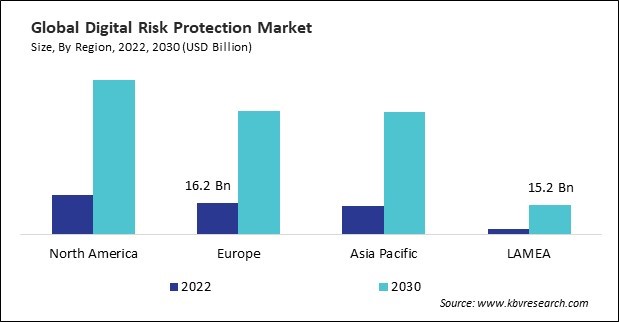According to a new report, published by KBV research, The Global Digital Risk Protection Market size is expected to reach $224.2 billion by 2030, rising at a market growth of 19.5% CAGR during the forecast period.
Integrated risk management (IRM) platforms are gaining traction as organizations seek holistic approaches to manage various risks, including cybersecurity, compliance, operational, and strategic risks. IRM platforms integrate digital risk protection capabilities with other risk management functions such as governance, risk, compliance (GRC), internal audit, and business continuity management. By centralizing risk data, streamlining workflows, and providing actionable insights, IRM platforms enable organizations to make informed decisions and prioritize risk mitigation efforts effectively.

The Services segment is experiencing a CAGR of 21.3% during (2023 - 2030). Managed security service providers (MSSPs) offer outsourced monitoring, detection, and response capabilities to organizations seeking to augment their in-house security operations. Managed security services include 24/7 security monitoring, threat detection and analysis, incident response, and remediation services delivered by a team of cybersecurity experts. By partnering with MSSPs, organizations can leverage advanced security capabilities, access round-the-clock support, and benefit from real-time threat intelligence without investing in additional resources or infrastructure.
The Large Enterprises segment is leading the Global Digital Risk Protection Market by Organization Size in 2022, thereby achieving a market value of $147.0 billion by 2030. Large enterprises often have diverse IT infrastructure: on-premises systems, cloud services, hybrid environments, and legacy applications. Managing and securing such diverse IT environments pose significant cybersecurity, data protection, and regulatory compliance challenges.
The On-premise segment is poised to have a CAGR of 17.6% during (2023 - 2030). On-premises digital risk protection solutions operate within organizations’ internal networks and infrastructure, reducing reliance on internet connectivity and third-party service providers for data storage and processing. This is particularly beneficial for organizations operating in remote or low-bandwidth environments where internet connectivity may be unreliable or limited.
The IT & ITeS segment is registering a strong potential in the Global Digital Risk Protection Market by Vertical in 2022, thereby, achieving a market value of $52.6 billion by 2030. The IT & ITeS segment mainly relies on third-party vendors, suppliers, and service providers to assist with their operations, which include software development, cloud hosting, and information technology outsourcing. However, third-party relationships introduce additional cybersecurity risks and vulnerabilities, as organizations may have limited visibility and control over the security practices of their vendors.
The Endpoint Security segment is anticipated to have a CAGR of 20.2% during (2023 - 2030). Endpoint security solutions include data loss prevention (DLP) capabilities that help organizations prevent unauthorized access, transmission, and exfiltration of sensitive data from endpoints. By implementing endpoint encryption, data classification, and data loss prevention policies, endpoint security solutions can identify and protect sensitive data stored on endpoints, monitor data transfers, and enforce data protection policies to prevent data loss and theft.
Full Report: https://www.kbvresearch.com/digital-risk-protection-market/
The North America region dominated the Global Digital Risk Protection Market by Region in 2022 thereby, achieving a market value of $80.7 billion by 2030. The Europe region is experiencing a CAGR of 19% during (2023 - 2030). Additionally, The Asia Pacific region would showcase a CAGR of 20.4% during (2023 - 2030).
By Offering
By Organization Size
By Deployment Mode
By Vertical
By Security Type
By Geography
 Unique Offerings
Unique Offerings